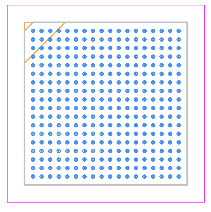Altera EP3C25F324I7N FPGA: Features, Applications and Datasheet
2024-11-26 10:51:19 993
The EP3C25F324I7N is a specific model of Cypress Semiconductor's (formerly Altera) Cyclone III FPGA family. It is designed for high-performance, cost-effective, and low-power applications, making it an excellent choice for a variety of embedded systems, industrial automation, and communication designs. The FPGA combines flexibility, advanced features, and an easy-to-use development environment, which appeals to both beginner and experienced FPGA developers.
EP3C25F324I7N Description
The EP3C25F324I7N is a member of the Cyclone III series from Intel (formerly Altera). It features 25,000 logic elements (LEs) and comes in a 324-ball BGA package (Ball Grid Array), making it suitable for a wide range of space-constrained applications. Cyclone III FPGAs are well-regarded for offering a good balance between performance, power efficiency, and cost, providing users with the flexibility to implement complex designs without breaking the bank.
Family: Cyclone III
Logic Elements (LEs): 25,000
Package: 324-Ball BGA
Speed Grade: -7 (which defines the maximum speed of the FPGA in its configuration)
Voltage: 1.2V core voltage
I/O Pins: Up to 125 I/O pins
Device Configuration: SRAM-based configuration
EP3C25F324I7N Features
25,000 Logic Elements (LEs): Offers a substantial amount of programmable logic, suitable for a range of applications requiring significant custom hardware processing capabilities.
Low Power Consumption: Designed with a focus on low-power consumption, making it ideal for battery-powered or energy-sensitive systems.
High-Speed Performance: The FPGA offers a high-performance capability for applications requiring fast processing speeds.
High I/O Count: With up to 125 I/O pins, the EP3C25F324I7N can be used in systems requiring extensive interfacing with other components or devices.
SRAM-Based Configuration: The SRAM-based configuration offers reconfigurability, which allows for dynamic changes in the logic functionality of the FPGA after deployment.
Clock Management: Features PLL (Phase-Locked Loop) circuitry and high-speed clocking features that make it suitable for high-speed applications requiring accurate timing.
Embedded Multipliers: Integrated DSP blocks that enhance the FPGA’s ability to handle data-intensive operations like filtering, signal processing, and other real-time tasks.
Integrated Memory Blocks: On-chip memory blocks such as RAM and ROM that facilitate efficient data storage and access during operation.
Integrated Transceivers: Provides high-speed serial data transfer capabilities, supporting protocols like SPI, PCIe, and Ethernet.
Configuration Security: Enhanced security features for protecting the intellectual property in your design.
EP3C25F324I7N Applications
The EP3C25F324I7N is used in a variety of applications across industries, including:
Embedded Systems: Ideal for custom computing solutions and hardware acceleration in embedded devices.
Telecommunications: Perfect for communication systems like modems, routers, and wireless communication modules due to its high-speed I/O and transceiver capabilities.
Industrial Automation: Used for control systems, sensors, actuators, and embedded control in industrial machines and robotics.
Signal Processing: With integrated DSP blocks and high-speed performance, it is suitable for real-time signal processing, including audio and video applications.
Medical Devices: Used in medical equipment for signal processing, real-time data handling, and image processing.
Consumer Electronics: Supports high-speed digital logic for devices such as cameras, gaming consoles, and multimedia systems.
Automotive: Utilized in automotive electronics for systems requiring fast data processing, like ADAS (Advanced Driver Assistance Systems) and infotainment systems.
EP3C25F324I7N CAD-Model
Symbol

Footprint

3D-Model


EP3C25F324I7N Alternatives
While the EP3C25F324I7N offers excellent performance and features, there are several alternative FPGA models from various manufacturers, including:
Xilinx Spartan-6 XC6SLX25: A competitor in the low-to-mid range FPGA category, offering similar logic capacity and features for cost-sensitive designs.
Intel Cyclone IV EP4CE22F17C8N: A lower-tier device in the Cyclone family with fewer logic elements (22,000) but similar performance and power efficiency.
Lattice Semiconductor MachXO3D: Lattice's low-power FPGAs for portable applications, providing both programmable logic and high-speed I/O.
Xilinx Artix-7: A mid-range FPGA offering enhanced performance, higher logic elements, and more advanced features compared to the Cyclone III series.
Microchip PolarFire FPGA: A low-power, mid-range FPGA family that provides both performance and security features, often used in applications like communications and industrial control.
EP3C25F324I7N FAQs
Can I use EP3C25F324I7N for machine learning applications?
While the EP3C25F324I7N is a capable FPGA for a wide range of applications, for machine learning tasks, especially deep learning, you may find that newer FPGA families like Intel's Stratix or Xilinx's Versal series, which include AI/ML optimizations, offer better support and performance.
What happens if I accidentally overwrite the FPGA’s configuration memory?
Overwriting the configuration memory of the EP3C25F324I7N would erase the current design loaded into the FPGA, causing it to revert to its default configuration. However, since it uses SRAM-based configuration, you can simply reload a valid bitstream file to restore the desired functionality.
Is EP3C25F324I7N capable of supporting HDMI video output?
While the EP3C25F324I7N does not have dedicated HDMI support out-of-the-box, it can be configured for HDMI output through proper design of the video signal processing blocks using its high-speed transceivers and DSP blocks. You would need to implement an HDMI transmitter in the FPGA design.
Can I use the EP3C25F324I7N for PCIe communication?
Yes, the EP3C25F324I7N has high-speed transceivers and can support protocols like PCIe, though it is typically limited to lower-speed PCIe standards. If you require high-bandwidth PCIe support (e.g., PCIe Gen 3), you may need to consider higher-end FPGAs such as the Cyclone V or Stratix families.
How do I mitigate the risk of overheating with the EP3C25F324I7N?
The EP3C25F324I7N has low power consumption, but as with any FPGA, it is important to manage the design's complexity, clock frequencies, and I/O load to prevent excessive heat generation. You may also need to consider additional cooling methods (e.g., heat sinks or active cooling) depending on the operating environment and workload.




